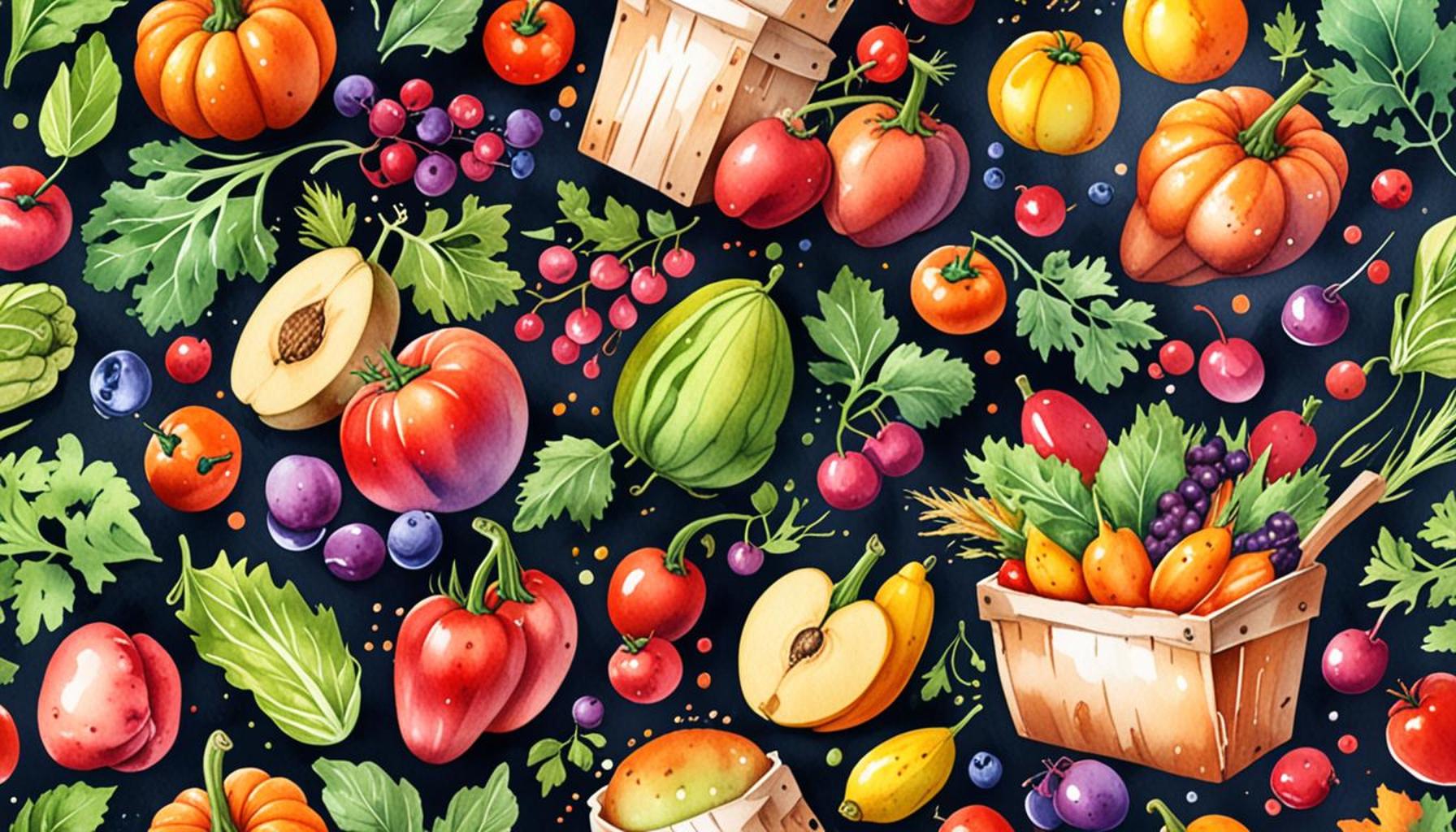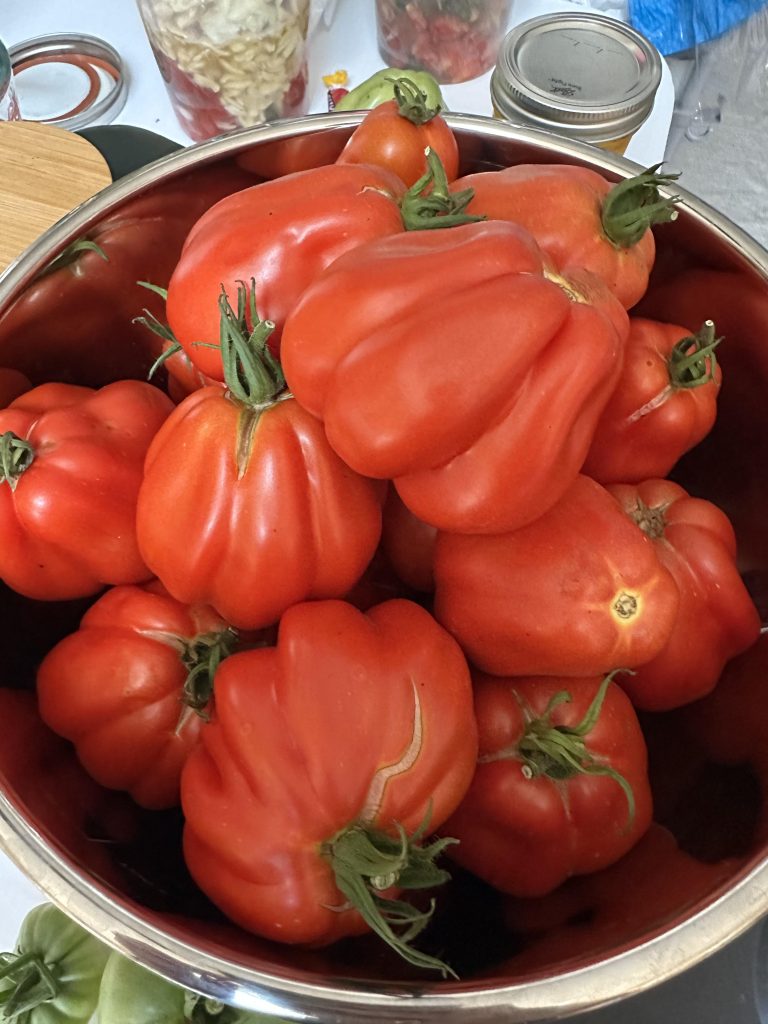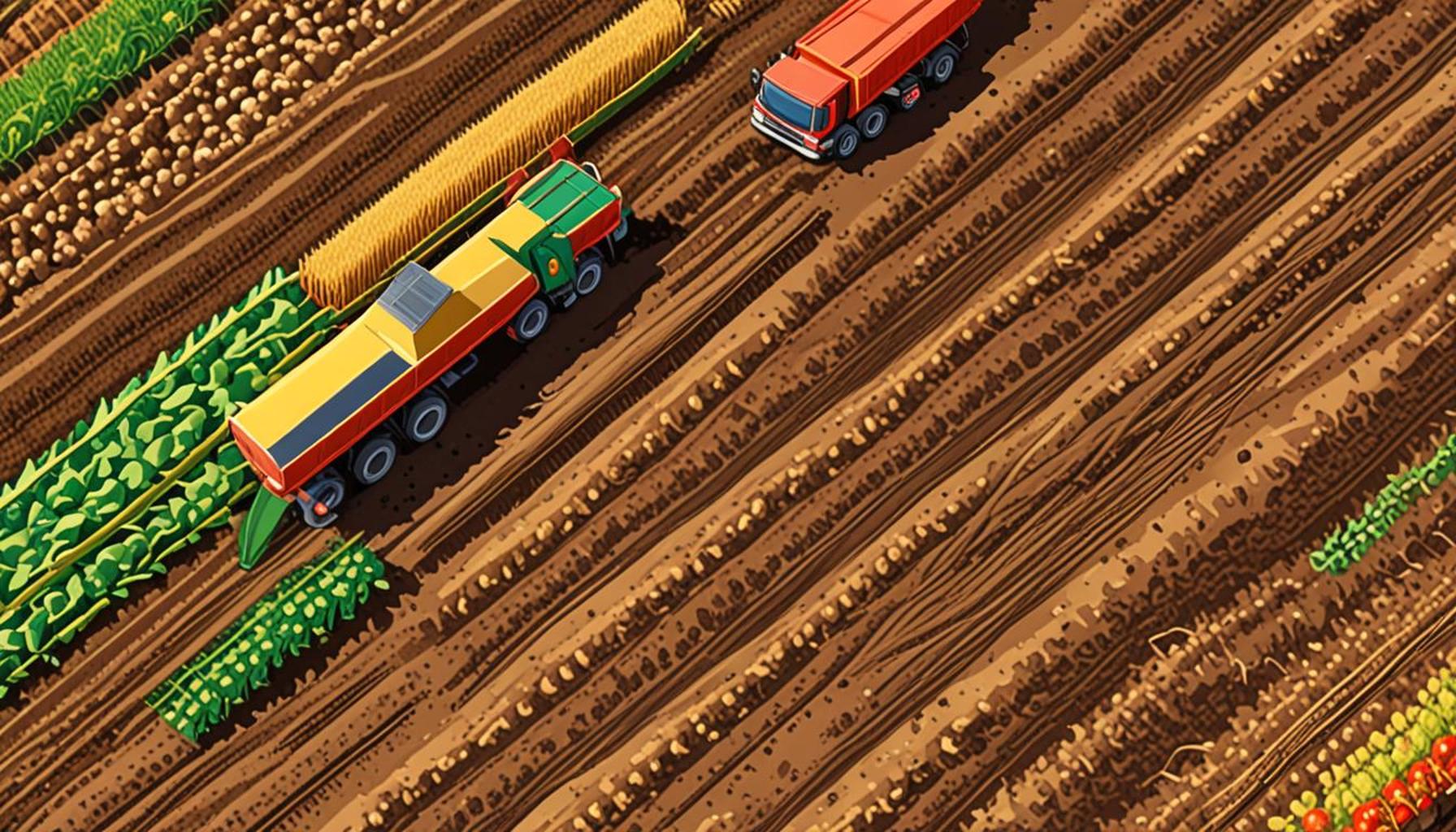Harvest and Preservation: Techniques for Storing Fresh Food After Harvest

The Importance of Food Preservation
Successfully storing fresh food after harvest is essential for maintaining quality, flavor, and nutritional value. Whether you’re a dedicated gardener nurturing a home garden or a consumer seeking ways to prolong the life of fruits and vegetables, mastering food preservation techniques can significantly enhance your culinary experience.
Consider the following techniques for preserving your harvest:
- Canning: This popular method for long-term storage involves sealing food in jars and heating them to destroy bacteria and enzymes. For example, making tomato sauce by canning allows you to enjoy the tastes of summer year-round. Furthermore, modern canning methods have simplified the process, making it more accessible for home cooks.
- Freezing: When it comes to preserving freshness, freezing is one of the best options. It locks in flavor and helps retain the nutritional content of food. For instance, flash-frozen berries maintain their taste and health benefits, making them an excellent choice for baking or smoothies during off-seasons. Most vegetables can be blanched before freezing, which helps preserve their texture and color.
- Drying: An ancient practice that removes moisture from food to prevent microbial growth. Dehydrating fruits can create delicious snacks like apple chips or raisins, while drying herbs can be integrated into many culinary applications. With various methods available—from air drying to using a dehydrator—this versatile technique is suitable for many types of produce.
- Pickling: By immersing food in vinegar or brine, this method not only enhances flavors but also extends the shelf-life of vegetables. Consider the crispness of pickled cucumbers or the bite of kimchi, which can elevate any sandwich or dish. Additionally, pickling can introduce exciting flavor profiles, merging the freshness of the harvest with rich spices and herbs.
The choice of preservation method may depend on several factors, including the type of produce, available storage conditions, and personal preferences. For instance, root vegetables like carrots and potatoes can be successfully stored in cool, dark places such as a cellar, while delicate fruits like berries may benefit from immediate freezing or canning to avoid spoilage.
By exploring these techniques and finding what best suits your needs, you can not only minimize waste but also enjoy the delicious flavors of your harvest long after the season ends. Understanding how to effectively harvest and store food can transform your cooking experiences and foster a more sustainable lifestyle, ultimately encouraging you to embrace local produce and reduce reliance on store-bought options.
Engaging in these preservation methods not only guarantees freshness but also supports local farming efforts. Next time you visit a farmer’s market, consider purchasing extra produce specifically for preservation. You might find that the richness of home-preserved foods becomes an indispensable part of your culinary repertoire.

DISCOVER MORE: Click here to learn about the impact of plant diversity on soil health
Harvesting: The First Step Towards Effective Preservation
The journey of preserving fresh food starts even before the canning jar is sealed or the freezer is packed with produce. Effective harvesting plays a crucial role in determining the longevity and quality of your fruits and vegetables. Understanding the right time and method to harvest can greatly affect the shelf life and taste of the produce. For instance, most fruits reach their peak flavor just before they are fully ripe, so it’s often best to harvest them slightly early. This allows them to ripen properly in controlled environments after harvest, prolonging their freshness.
Knowing the optimal times to harvest various types of produce can significantly influence your preservation strategy. Fruits such as apples and tomatoes often respond well to being picked right before full ripeness, as they can continue to develop flavor and texture post-harvest. On the other hand, leafy greens like spinach and lettuce should be collected while still crisp and vibrant, as they wilt quickly if left too long on the plant. Timing is critical, and weather conditions can also affect harvesting—picking after a rain can lead to mold or rot, so plan accordingly.
Techniques to Optimize Harvesting
Once you’ve determined the best time to gather your produce, employ techniques that will preserve not only the quality of the food but also the efficiency of your harvest. Here are some best practices to consider:
- Use the Right Tools: Tools such as sharp shears or harvesting knives make a significant difference. They minimize damage to the plants and reduce the chances of bruising or hastening spoilage.
- Avoid Harvesting in Heat: Morning or evening is the best time to harvest, as cooler temperatures help maintain freshness. Picking in the heat of the day can lead to wilting.
- Handle with Care: Once harvested, it’s crucial to handle your produce gently to minimize bruising. Bruised fruits and vegetables are more prone to spoilage!
- Immediate Cooling: If possible, cool your harvest quickly by placing it in a cool, shaded area or in a refrigerator. This step slows down respiration and spoilage rates.
By implementing these harvesting techniques, you can set the stage for successful preservation. The faster you can transition from harvest to preservation, the better your chances of enjoying that freshly picked taste long into the future. The next step involves choosing the proper preservation method that aligns with your harvest. Each technique carries its own advantages and requirements, making it essential to evaluate your options carefully in relation to what you’ve gathered.
As you embark on this journey, remember that each method of preservation enhances the flavors and nutritional density of your foods. The practices you adopt after the harvest are as important as the care you take during growth. Now, let’s dive deeper into specific preservation methods that will help you maximize the shelf life of your produce.
| Technique | Advantages |
|---|---|
| Canning | Canning not only preserves food but also offers a long shelf life and retains nutritional value. |
| Freezing | Freezing helps to lock in freshness and flavor, allowing for easy meal preparation at a later date. |
| Dehydration | Dehydrated foods are lightweight and portable, making them ideal for storage and travel while still retaining essential nutrients. |
| Fermentation | Fermentation enhances flavor and offers probiotics that benefit gut health, providing an added nutritional punch. |
In exploring the various techniques of “Harvest and Preservation: Techniques for Storing Fresh Food After Harvest,” we reveal invaluable methods that cater to diverse preservation needs. Methods such as canning, freezing, dehydration, and fermentation not only prolong the lifespan of fresh produce but also enrich the food preservation landscape.Canning, for instance, emerges as a viable way to not just secure the longevity of fruits and vegetables, but also enhance their flavor while keeping a significant portion of their nutritional benefits. On the other hand, freezing proves advantageous by effectively maintaining the vibrant freshness and taste of food; it allows for a quick and easy meal solution that busy individuals appreciate.Another powerful method, dehydration, not only creates lightweight food options for those on the go but also conserves the essential nutrients that make our produce beneficial. Additionally, fermentation not only serves as a preservation technique but also transforms ordinary foods into gourmet treats rich in probiotic advantages.Discovering these techniques can revolutionize how you think about your harvest, enabling a world where fresh food is abundant year-round regardless of external conditions. Whether you’re a home gardener or a culinary enthusiast, mastering these techniques will significantly enhance your food experience.
DISCOVER MORE: Click here to learn how plant diversity boosts soil health
Preservation Techniques: Extending the Life of Your Harvest
Once you’ve harvested your produce with care, the next crucial step is selecting the right preservation technique. Different fruits and vegetables demand unique methods to maintain their freshness, flavor, and nutritional content. Whether you’re looking to enjoy the taste of summer fruits in winter or need to preserve a bumper crop from your garden, understanding various preservation techniques is essential.
Canning: Locking in Freshness
Canning is a popular method for long-term food preservation that allows you to store fresh produce in airtight containers. The high temperature used during the canning process kills off bacteria and seals the food, which makes it safe for extended storage. For example, tomatoes, peaches, and pickles are frequently canned. When canning, remember to use acidification methods, such as adding vinegar to pickles or lemon juice to tomatoes, as this helps preserve color and prevents microbial growth.
One important aspect of canning is to follow preservation guidelines from reliable sources, such as the USDA, to ensure safety and quality. You’ll need the right equipment, including a pressure canner for low-acid foods and a water bath for high-acid foods. It’s a rewarding process that, when done correctly, allows you to savor your homegrown produce year-round.
Freezing: Nature’s Refrigerator
Freezing is another simple yet effective way to preserve the freshness of your fruits and vegetables. This method locks in flavors and nutrients while significantly extending the storage life of food. Most items can be frozen directly, but it’s advisable to blanch vegetables first. Blanching stops enzyme actions, preserves color and flavor, and reduces loss of vitamins. For instance, blanching your green beans in boiling water for a couple of minutes before freezing them can keep them crisp and vibrant.
Labeling your frozen items with the date and type of food is essential, as it helps track storage time and avoid freezer burn. Generally, frozen produce remains at its best quality for 8 to 12 months, making it practical for long-term food storage.
Dehydration: Nature’s Concentration
Dehydration is an ancient preservation technique that involves removing moisture from food to prevent spoilage. This method can extend shelf life for years and concentrates flavors, transforming fresh fruits, vegetables, and herbs into lightweight snacks or ingredients. A dehydrator or an oven can be used to dry your harvest. While fruits like apples and bananas make delightful snacks when dried, you can also dehydrate vegetables like tomatoes and peppers for use in soups and stews.
Properly dehydrated food should be stored in an airtight container in a cool, dark place to maximize longevity. It’s important to ensure the food is adequately dried, as any residual moisture can lead to spoilage.
Fermentation: A Flavorful Preservation Method
Fermentation is not just a trendy food movement; it is a time-honored method for preserving food while enhancing its flavors. Foods such as sauerkraut, kimchi, and pickles benefit from fermentation, which cultivates beneficial bacteria while prolonging shelf life. This method can also increase the nutritional value of your produce, making it a prime choice for health-conscious individuals.
When fermenting your produce, the key is to maintain a clean environment and use the right salt concentrations to promote the growth of good bacteria while inhibiting harmful ones. Experimenting with fermentation can open new culinary doors, allowing you to enjoy your garden harvest in unexpected and delicious forms.
Understanding these preservation techniques empowers you to extend the bounty of your harvest, allowing you to relish the fruits of your labor even in the off-seasons. Each method offers unique benefits, transforming your fresh food into long-lasting provisions that you can enjoy year-round.
DISCOVER MORE: Click here to learn about cover crops
Conclusion: Maximizing Your Harvest’s Potential
In conclusion, the journey from garden to table can be greatly enhanced through effective harvest and preservation techniques. Each method discussed—from canning and freezing to dehydration and fermentation—offers distinct advantages that cater to different needs and preferences. Understanding these techniques not only allows you to savor the peak flavors and nutrients of your homegrown produce but also equips you with the skills to minimize food waste and maximize your harvest’s potential.
Furthermore, as sustainability gains importance in our society, it becomes increasingly relevant to embrace these preservation methods. By preserving our fresh food, we can reduce our reliance on commercial supply chains and decrease the environmental impact associated with food production. Whether you’re enjoying summer tomatoes in the depths of winter or snacking on dehydrated apples, the satisfaction of knowing you extended your harvest through thoughtful preservation cannot be overstated.
For those eager to delve deeper, numerous resources, including community workshops and farmer’s markets, are available to enhance your preservation skills. As you explore these methods, don’t hesitate to experiment and discover what works best for your culinary style. Remember, harvesting is just a part of the journey; preserving unlocks the full potential of your fresh produce, ensuring you can enjoy it whenever you wish.



